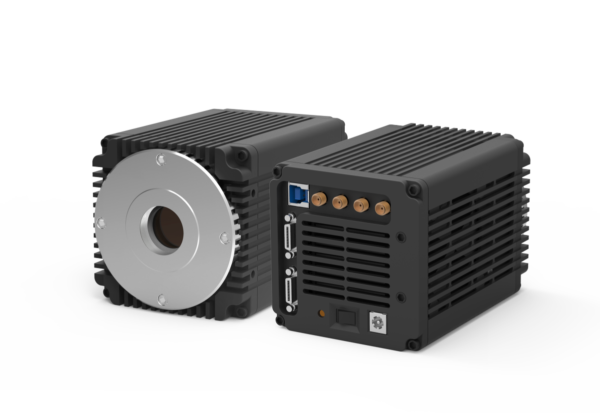ORCA-Lightning sCMOS
Sensor technology
sCMOS
Resolution
4608 × 2592 / 11.9 MP
Pixel pitch
5.5 µm x 5.5 µm
Sensor mode / Frame rate
Rolling Shutter / 121 fps
Readout noise
2.0 e- rms
Interface
CoaXPress 6×4
The ORCA-Lightning has doubled speed, resolution and field of view relative to current scientific cameras. Compared to a Gen II sCMOS, the ORCA-Lightning delivers 2 times the pixel area, 2.8 times the pixels and 3.4 times faster pixel-per-second readout. All these increases translate to the ability to capture more image data faster, and still achieve Hamamatsu-quality images and information content.
ORCA-Lightning can even take high-speed images which were difficult to fully capture until now, with approximately 6 times the readout speed, while maintaining a level of readout noise similar to that of ORCA-Flash4.0 V3. Cameras used in light-sheet microscopes put emphasis on high speed, demanding fast readout. Because images with increased readout speed result in obtaining fewer photons upon capture, it is necessary to keep the camera’s readout noise low when trying to capture high S/N images. ORCA-Lightning can capture images at approximately 6 times the readout speed, while maintaining a level of readout noise similar to that of ORCA-Flash4.0 V3.
Using CoaXPress as an interface and optimizing high speed data transfer to the PC, ORCA-Lightning realizes high-speed image acquisition.

Readout speed (for each effective number of pixels and modes)
Customers can select the best mode depending on their usage. In addition to a readout from a Standard Full Well Capacity mode (12 bit), ORCA-Lightning also supports a readout from a High Full Well Capacity mode (16 bit) for high dynamic range.

High speed test of 3D imaging
3D imaging of a free-swimming Volvox produced by taking consecutive images. When capturing the image of a free-swimming Volvox, imaging speed of 2-dimensional (area of observation) and 3-dimensional (number of images) settings were selected with a precondition of approximately 8 volumes per second.
ORCA-Lightning can capture clearer images within a wide range compared to ORCA-Flash4.0 V3 thanks to its high speed.
Imaging conditions
- Microscope: ezDSLM (light-sheet microscope)
- Objective lens: 10×
- Excitation wavelength: 488 nm
- Fluorescence wavelength: red (autofluorescence)
- Sample: Volvox
- Observation target: Free-swimming Volvox
- Method of imaging: Acquisition of approximately 8 volume image (stereoscopic) per second

Field of View Comparisons

ORCA-Lightning covers the twice large field of view compared to ORCA-Flash4.0 V3, so that it can improve throughput and efficiency of work. Sample images below shows the FOV comparison of the same images taken with Lightning and Flash4.0 V3.
| Sample | Test Pattern | Dendritic spines of neuron |
| Imaging Conditions |
|
|
PC recommendations
With the introduction of the ORCA-Lightning, users are now able to stream 12 megapixel images to their computers 121 frames per second. The computer recommendations for this high data rate can be met by using the guidelines listed in PC Recommendations for ORCA-Lightning. Please find the document in the downloads tab
Description
The ORCA-Lightning High-speed sCMOS Camera
The ORCA-Lightning is a high speed sCMOS camera that has doubled speed, resolution and field of view relative to current scientific cameras. Compared to a Gen II sCMOS, the ORCA-Lightning delivers 2 times the pixel area, 2.8 times the pixels and 3.4 times faster pixel-per-second readout. All these increases translate to the ability to capture more image data faster, and still achieve Hamamatsu-quality images and information content.
ORCA-Lightning high speed sCMOS camera can even take high-speed images which were difficult to fully capture until now, with approximately 6 times the readout speed, while maintaining a level of readout noise similar to that of ORCA-Flash4.0 V3. Cameras used in light-sheet microscopes put emphasis on high speed, demanding fast readout. Because images with increased readout speed result in obtaining fewer photons upon capture, it is necessary to keep the camera’s readout noise low when trying to capture high S/N images. ORCA-Lightning can capture images at approximately 6 times the readout speed, while maintaining a level of readout noise similar to that of ORCA-Flash4.0 V3.
Using CoaXPress as an interface and optimizing high speed data transfer to the PC, ORCA-Lightning realizes high-speed image acquisition.
Customers can select the best mode depending on their usage. In addition to a readout from a Standard Full Well Capacity mode (12 bit), ORCA-Lightning also supports a readout from a High Full Well Capacity mode (16 bit) for high dynamic range.
3D imaging of a free-swimming Volvox produced by taking consecutive images. When capturing the image of a free-swimming Volvox, imaging speed of 2-dimensional (area of observation) and 3-dimensional (number of images) settings were selected with a precondition of approximately 8 volumes per second.
ORCA-Lightning high speed sCMOS camera can capture clearer images within a wide range compared to ORCA-Flash4.0 V3 thanks to its high speed.

Manufacturer’s website: https://www.hamamatsu.com/us/en/product/type/C14120-20P/index.html
For more CMOS and CCD cameras: https://axiomoptics.com/scientific-industrial-cameras/#low-light-cameras














































